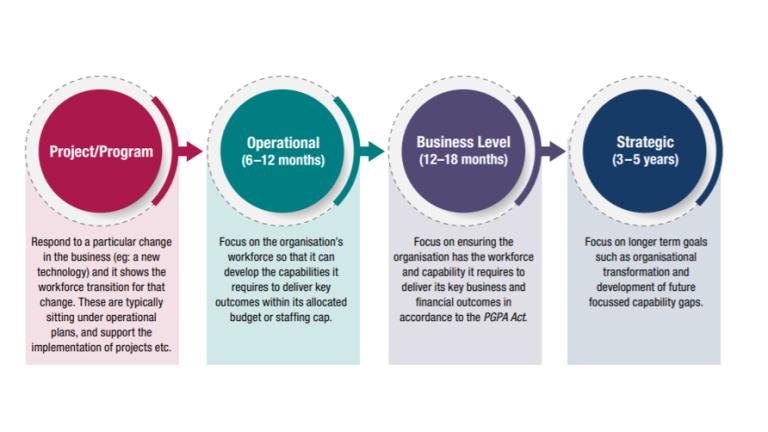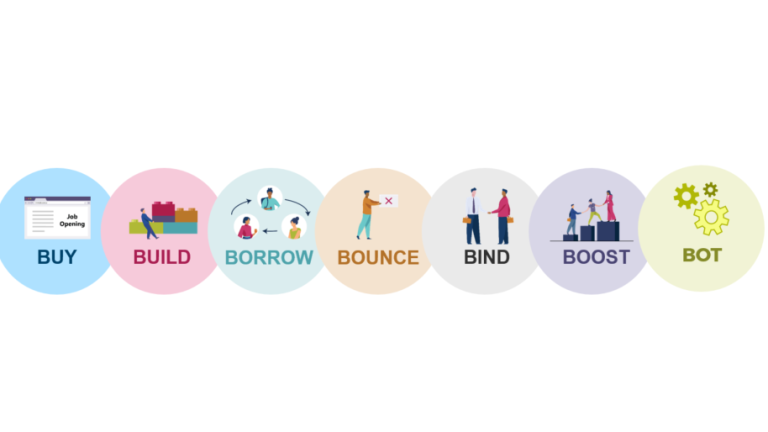APS Centre Excellence for Workforce Planning
In today's fast-paced environment, do you find yourself juggling an array of workforce challenges—from tight budget constraints and staffing caps to the perpetual push to do more with less? If that’s you, keep reading. We’ve compiled some tips so that you don’t get caught with your plans down!
So what is workforce planning?
You’ve heard the cliché 5R definition of the right people with the right skills in the right place at the right time for the right cost. We’d like to introduce 3 workforce characteristics that help to define the goal of workforce planning efforts.
Aligned – Aligning people, skills and capabilities, technology and processes with strategic objectives.
Adaptive – Adapting to changes and challenges ensuring ongoing workforce readiness.
Anticipatory – Anticipating future challenges, opportunities and needs to proactively position the workforce.
What’s my role in workforce planning?
Workforce planning is the process of getting an organization’s people ready for the future. For this to work, leaders at every level should be actively involved in aligning their teams with agency goals. For supervisors, your role will be focused on your team’s capability and capacity to deliver. For Senior Executive leaders, your role will be more strategic focusing on building pipelines, ensuring bench strength and safeguarding long term sustainability of the agency. The following visual shows different types of workforce planning according to their time horizons. Short term plans typically span from 6 – 24 months whilst longer term plans are upwards of 3 years.

Most agencies have an established business planning process led by a corporate service function. This shouldn’t be viewed as a compliance activity. Rather, it as a trigger to consider your key workforce risks, skill needs, capacity considerations and actions to address these.
How do I identify my key risks?
We recommend using your agency’s risk matrix to identify key workforce risks impacting you. Alternatively, you can find helpful guidance through these checklists. By going through these questions and answering them, you’ll be able to ascertain the risks impacting your team. See Key Workforce Planning Questions for Leaders and Workforce Planning Guiding Questions (full).
How can I address these risks?
Once you’ve identified the key workforce risks impacting you and your team, it’s time to consider how you might address these. We have adapted various models and developed the 7Bs of workforce risk mitigation. Use this as a guide as you’re considering appropriate risk mitigation measures. Please note that these are not in order of importance.

Buy – Bringing in capability from outside the agency
Build – Developing capability within the agency
Borrow – Obtaining capability from outside the team through non-ongoing means
Bounce – Removing low performers or eliminating redundant roles
Bind – Retaining talented employees within the agency
Boost – Offering promotions, advancements or role expansion for talented high performers
Bot – Optimising productivity through automation and use of AI
Some of these actions can be implemented in months whilst others may take years. This is why we advise leaders to review their workforce plan regularly. Use change (e.g. changes in agency priorities, staffing levels, service delivery requirements etc.) as a trigger to review, validate and adjust your plan where necessary.
In conclusion
We live in a dynamic and changing world that requires leaders and organisations to be ready and responsive. Through proactive workforce planning rather than being caught with your pants plans down, you can confidently face challenges today and tomorrow!
What's next?
Want to find out more about workforce planning? Contact us at the Centre of Excellence for Workforce Planning.




